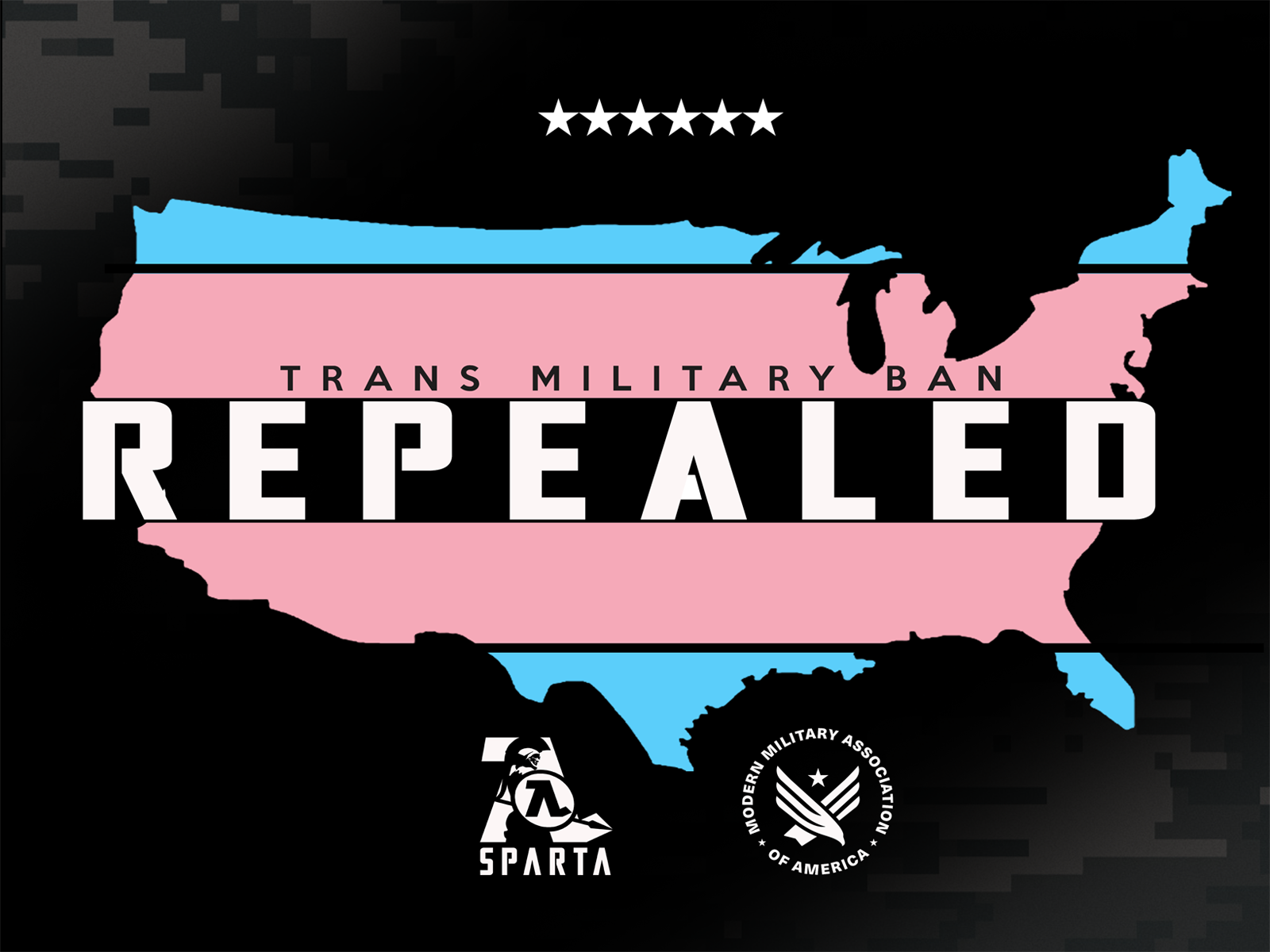This article first appeared in the February 2021 issue of Modern Military Magazine. Read the original article here.
Transgender troops can finally take a deep breath: President Biden has made good on his promise to repeal the Trump administration’s arbitrary ban on transgender service in the military.
This historic move comes over three years after President Trump first announced via Twitter that he planned to ban transgender people from serving — a year after the Obama administration first gave them the right to do so.
It’s impossible to quantify the struggles transgender troops and their families endured over the past few years, and how much organizations like MMAA, ACLU, and Lambda Legal did to advocate for them. The courtroom decisions, events and policies evolved so rapidly over the years that it became difficult for anyone to keep up unless they were directly impacted.
It has been a hard-fought battle to get to today, where there is finally, once again, full LGBTQ equality in the military. This is the story of how the unpopular trans ban 2.0 came to be, how it impacted the transgender community, and why the Biden administration’s repeal of it is so meaningful.
A long-time ban is lifted
Zane Alvarez struggled with his gender identity throughout his childhood and teens. In his twenties, he acknowledged that he was transgender and desperately wanted to take steps to live authentically.

Zane Alvarez, a transgender soldier
But he faced a sizable barrier: He was an active duty Army soldier, and the military still had a long-standing ban on transgender service. When the Don’t Ask, Don’t Tell policy was repealed a decade ago, it only applied to gay, lesbian, and bisexual troops. Transgender service members were left behind to serve in silence.
Alvarez wanted to go by male pronouns and adhere to male regulations, but given that he had no legal right to do so, his leadership wouldn’t tolerate it.
Soon after, in the summer of 2016, Alvarez was elated when President Obama’s Secretary of Defense, Ash Carter, announced the repeal of the trans service ban. Alvarez and the thousands of other closeted trans troops could finally come out and transition without facing repercussions or discharge.
As this new policy rolled out, some branches began providing transgender awareness trainings to enlighten all troops on this new inclusive policy. Some military doctors took the initiative to develop competency in transgender health care, and while the new policy wasn’t perfect and not all military leadership showed support to these newly-out trans troops, the kinks were slowly starting to get worked out. Initially, the new policy applied only to those currently serving, but it would later be rolled out to accept new transgender recruits.
The tweets that changed everything
After the ban repeal freed Alvarez to live authentically in all walks of life, he obtained his legal gender marker change and updated his passport in the civilian world. His next milestone was obtaining gender-affirming healthcare. Despite the ban repeal, there was still plenty of red tape to overcome, and it took him around six months to acquire all of the requested doctor letters, documentation, and Tricare approval.
It was almost exactly a year since the trans ban was lifted, and Alvarez was thrilled to move forward. “But literally the day after receiving Tricare approval, the tweets came out,” he recalls.
He’s referring to a string of surprise tweets by President Trump in July 2017 insisting that transgender people would no longer be allowed to serve in the U.S. military. A year after the prior administration said it was safe for trans troops to come out, the current one was now turning its back on them.
“Even though they were characters on a social media outlet, nothing set in stone, I contacted Tricare and they said after what Trump said, they would no longer approve my gender-affirming care,” Alvarez explains. “I asked if there was a new policy or if someone had signed something, and I attempted a second time, but nothing came of it and I got the run-around.”
Despite his care being deemed medically necessary and eligible for Tricare, he now had to use his own money and his own leave for certain aspects of transition-related care.
While the president’s infamous tweets claimed he made the decision after consulting with military leadership, it later surfaced this was false and had actually blindsided most of the Pentagon. This prompted military leadership to speak out against reimplementing a ban, and the Joint Chiefs of Staff stated that they weren’t aware of any negative effects of trans troops serving. The administration provided an ever-changing litany of excuses for their reasoning, all of which were swiftly debunked.
In January 2018, the part of the Obama-era policy that allowed new transgender recruits to enlist kicked in. Even though a potential second ban was looming, some trans people were able to join during this brief window.
But the Trump administration persisted and spent years fighting for the ban in courtrooms across America. Trans troops spent these tumultuous years on edge as the outcome loomed, unsure would happen to their careers and livelihoods.

The author, left, and her wife Jamie Hash, a trans Airman
Ultimately, the administration succeeded and turned the impulsive tweets into policy, effective on April 12, 2019. It was announced just two months beforehand, and the new rules required any current troops who wanted to transition to obtain a gender dysphoria diagnosis before then.
This created a scramble and put some troops who hadn’t yet come out in the position of having to make a decision quicker than expected. The military healthcare system isn’t efficient to begin with, and troops who were deployed, on bases without military treatment facilities, or couldn’t obtain appointments in time were left behind. Additionally, some doctors require multiple visits to make this diagnosis, and there are some accounts of military doctors denying it altogether.
The Trump trans ban went into effect with an ambiguous exemption clause. It permitted those diagnosed with gender dysphoria before April 12 (including those who came out under the Obama administration) to stay in and take transition-related steps. But after that date, all troops would be required to serve in their sex assigned at birth. That means any other trans troops would not be able to use their correct pronouns, use the facilities that aligned with their gender identity, utilize dress and appearance standards they identified with, or access transgender-related health care.
Additionally, the military would no longer allow trans people to join, ending a dream for many young people who had hoped to take the sacred oath to serve their country. Even those grandfathered in would not be permitted to commission as officers.
Advocates of the policy claimed it wasn’t a ban since troops would still be allowed to “come out” and say they’re trans without facing discrimination, but they weren’t allowed to take any steps to serve authentically. For all intents and purposes, it was another ban on trans service.
Trans troops in limbo
When the new trans ban policy went into effect, trans troops who met the requirements of the exemption clause could finally take a deep breath, knowing they wouldn’t simply be kicked out.
But it wasn’t that simple. The exemption clause was vague, creating anxiety and uncertainty about how solid their careers really were and how it would impact their families. Despite being part of this finite group that previously came out and got to stay in, Alvarez and these troops faced scrutiny and ongoing challenges.
Approximately 1,600 trans troops came out when the Obama administration lifted the ban, says Lt. Col. Bree Fram, a rocket scientist and Air Force (soon-to-be Space Force) officer currently at the Naval War College in Newport, Rhode Island.
Fram is also Vice President and Communications Director of SPART*A, an organization that advocates and educates about transgender military service. She had started coming out in her personal life, but she was still serving in her sex assigned at birth. Upon the announcement of the new ban and its deadline, Fram no longer had the luxury of going at her own pace. She scrambled to meet the requirements that would allow her to live authentically rather than potentially spend the rest of her career serving in silence.

Lt. Col. Bree Fram and family
While the Trump administration’s implementation of a ban kept otherwise qualified people from joining the military, Fram says, it also placed a huge burden on those already serving.
For example, even though Alvarez’s civilian legal documents now identified him as male and he was allowed to continue serving under the exemption clause, he couldn’t get the Army’s Human Resources Command to change his gender marker in his personnel file.
As a behavioral health technician, he goes out on tactical field care missions for weeks or months at a time, living in close quarters with other soldiers. “I clearly present as male, and them putting me with females where we share showers and housing would be incredibly awkward and inappropriate,” Alvarez says. “There was a big ‘F’ on my paperwork, and they didn’t want to deal with the potential repercussions of putting me out in a field environment or on these missions and roomed with females. In turn, there were quite a few missed opportunities.”
Eventually, a colonel intervened on Alvarez’s behalf and helped ensure his file was updated, ending this particular issue. But countless other trans troops caught in this limbo tell stories of being turned down for assignments, professional development opportunities, training, transition-related medical care, and more — simply because their medical and personnel records reflected that they were trans and leadership struggled to navigate the new policy.
Fram says the challenges that currently-serving trans troops face go far beyond the logistical. She points out that when your commander in chief tweets that you’re a burden to your own military, it adds external pressure and imposes an unnecessary psychological challenge.
Despite the Trump administration holding firm on their stance, public opinion swayed further in support of trans troops. In a 2019 Gallup poll, over 70% of Americans surveyed said they supported allowing transgender people to serve openly in the military.
“Our example has been outstanding, as there have been people serving all over the world, showing they’re capable of completing their mission even in a challenging environment,” Fram says. She also notes that when Obama’s ban repeal policy was released, it had rough edges that were expected to get smoothed out over time. “Yet when the ban went into place in the next administration, there was little to no impetus to fix any of those areas of the policy that were problematic,” she says.
A new progressive era
In early 2020, when President Biden was still on the campaign trail, he vowed to reinstate the LGBTQ rights and protections that the Trump administration took away. As a military parent and long-time ally of the LGBTQ community, he made it clear he planned to support all military families.
He promised to end the trans military ban on Day One, and while he did sign a Day One executive order that benefitted the LGBTQ community, he didn’t order the repeal of the ban until January 25, 2021. But at long last, it’s done, and transgender troops can finally exhale.
Shawn Skelly is a retired U.S. Navy Commander, and when President Obama appointed her in 2017 to serve as a Commissioner of the National Commission on Military, National, and Public Service, she became the first transgender veteran to be appointed by a U.S. president. Skelly is also vice president and co-founder of Out in National Security, and most recently, she served on the Biden-Harris Presidential Transition Team.

Shawn Skelly
Skelly says the incoming administration isn’t stopping at the trans service ban; she’s confident it will work to keep moving things forward.
“President Biden’s action regarding transgender service members, as meaningful as it as in message and practical effect, shouldn’t be viewed as simply the reversal of a bigoted, deceitful policy,” Skelly tells MMAA. “It should instead be considered an important, deliberate step forward to actual inclusion and respect for all Americans. America is neither well nor best served until those who serve her, in every capacity, whether uniformed or civilian, represent the full, diverse panoply of the American people.”
The Biden administration has been vocally supportive of the LGBTQ community as a whole and has vowed to enact and enforce the Equality Act within his first 100 days. After four years of facing assaults on their rights, both in the civilian world and in the military, countless transgender troops feel relief now that the tide is finally turning.
“America is either all of us or none of us,” Skelly says. “The mission we charge them to perform and the esteem we bestow upon our military service members demands that they not only be among the best of us by qualification and capability, but that they represent us in full. Abraham Lincoln’s words ‘of the people, by the people, for the people’ must be considered existential and kept eternal. Correcting the unjust treatment of transgender service members is today’s consequential step in that vital journey.”
Fram notes that the old policy required a large administrative burden for trans troops, their commanders, and the medical teams. She looks forward to digging into the new Biden administration policy and seeing it improve over time as needed.
She notes that may take several months for the new policy to be signed and implemented. “We urge people to be patient, since it may take a little time before the policy is in a place where trans folks can join, and for people to be able to easily access the care that’s deemed medically necessary under the new policy.”
While the new policy may not be perfect at first, she says,“to have this weight lifted from our shoulders is an amazing opportunity for us to strive to be our best, and not have to do so in an environment that is systematically against us reaching those goals.”
Fram says trans troops want to be judged like any other — based on their service and performance alone. Now that President Biden has followed through on his promise to restore open service for transgender troops, this will hopefully be possible now, and forever.
“We believe that after four or eight years, we’ll get to a point where a military without trans service members is just as unconscionable as a military without African Americans, without women, or without lesbians, gays, or bisexuals,” Fram says.
Emily Starbuck Gerson is the proud spouse of an active duty transgender Airman. She and her wife are currently stationed overseas. Emily is an award-winning freelance journalist who is currently serving as MMAA’s editor-in-chief. She also previously sat on the Advisory Board for Military Family Advisory Network.


